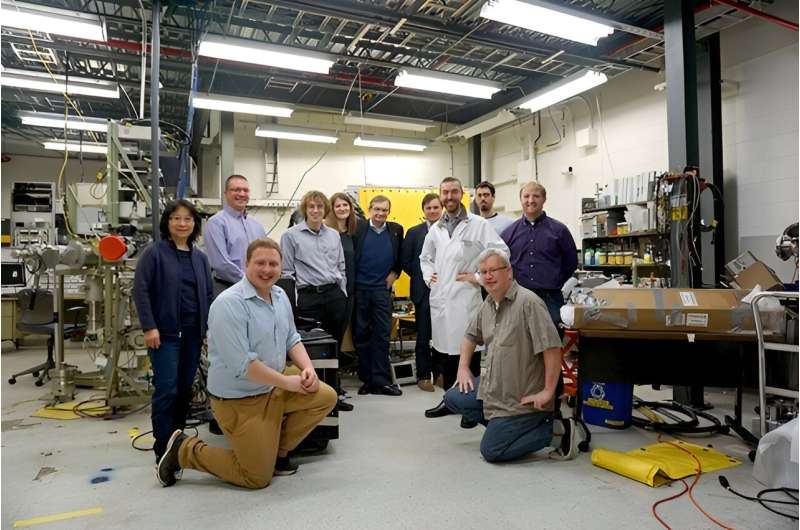This article has been reviewed according to Science X's editorial process and policies. Editors have highlighted the following attributes while ensuring the content's credibility:
fact-checked
peer-reviewed publication
trusted source
proofread
Collaboration identifies rare nuclear decay in long-lived potassium isotope

Some nuclei of certain elements decay radioactively into nuclei of different elements. These decays can be useful or annoying depending on the context. This is especially true for potassium-40. This isotope usually decays to calcium-40, but about 10% of the time it decays to argon-40.
This decay path involves a process called electron capture which provides information about nuclear structure. It can also determine the age of geological objects on billion-year time scales, because potassium-40 has a very long half-life. The long half-life makes finding additional ways potassium-40 decays challenging.
Now, a month-long campaign made the first direct observations of a very rare but critical decay path of potassium-40 to argon-40. The result may improve scientists' understanding of physics processes and increase the precision of geological dating. The research is published in the journal Physical Review Letters and Physical Review C.
Most electron capture decays of potassium-40 lead to an excited form of argon-40. The Potassium Decay (KDK) Collaboration measured a rare, theoretically calculated electron capture decay that instead leads to the potassium-40 ground state. The theoretical calculations have a wide range of predictions. This range limits the use of potassium-40 for determining the age of geological and solar system features.
The team's experimental result reduces this range. The result also improves the estimates of potassium properties that scientists need for certain physics experiments.
Finally, the result suggests that neutrinoless double-beta decay occurs at lower than expected rates for nuclei of light elements.
Radioactive nuclei decay by one or more modes, and these decays result in more stable isotopes. The KDK Collaboration measured a rare decay branch of potassium-40 at the Holifield Radioactive Ion Beam Facility of Oak Ridge National Laboratory (ORNL) using the KDK array (K=Potassium DK=Decay). The KDK array consists of ORNL's Modular Total Absorption Spectrometer, coupled with a specially designed silicon drift X-ray detector.
Quantifying the decay rates of potassium-40 and its decay branches is difficult because measurements must be made of the parent nucleus and a sufficient number of rare offspring. The KDK Collaboration studied a subset of potassium-40 that decays to argon-40 by electron capture, which makes up about 10% of all potassium-40 decays.
While most potassium-40 electron-capture decays emit a characteristic gamma ray that is a background in most experiments, a small subset of these decays happens without any gamma-ray emission. This happens when potassium-40 captures an electron that goes directly to the argon-40 ground state.
The KDK Collaboration made the first direct measurement of this decay. The achievement indicates other decay rates may also need reassessment. The rare decay branch that the KDK Collaboration identified and measured provides unique experimental evidence of so-called forbidden beta decays, affects nuclear structure predictions, and removes a longstanding uncertainty for potassium-based geological and solar system age estimates.
The findings also improve the assessment of the background present in experiments searching for new physics beyond the Standard Model.
More information: M. Stukel et al, Rare K40 Decay with Implications for Fundamental Physics and Geochronology, Physical Review Letters (2023). DOI: 10.1103/PhysRevLett.131.052503
L. Hariasz et al, Evidence for ground-state electron capture of K40, Physical Review C (2023). DOI: 10.1103/PhysRevC.108.014327
Journal information: Physical Review Letters , Physical Review C
Provided by US Department of Energy





















